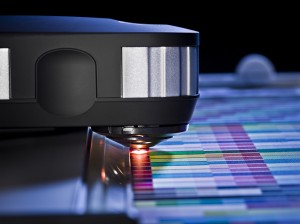Many print shops use more than one color measurement instrument, especially for cross-media color reproduction. But if you’ve ever measured the same color with different instruments, you’ve probably noticed that the numbers don’t always match.
Why is that?
Spectrophotometers measure color by capturing the ratio of reflected or transmitted light from the surface of the sample and comparing it to a known reference standard. The result is a spectral fingerprint for that color. But since calibration standards and reference databases vary slightly among models and manufacturers, the same color sample can produce different spectral fingerprints.
If your shop is using more than one instrument, which numbers do you believe and how do you create standard operating procedures?
This is the issue that prompted X-Rite to introduce the XRGA Graphics Art standard for factory calibration. It not only solves this metrology issue, but also incorporates new advances in color technology and the latest ISO standards.
Making Color Measurement History
Back in 2006 when X-Rite and GretagMacbeth joined forces, it became apparent that the calibration standard differences would cause issues for our customers who wanted to use devices from both. X-Rite developed XRGA standards to merge these systemic variations so that all of our customers – regardless of legacy affiliation – can achieve high quality data exchange among instruments and sites.
XRGA delivers quality data exchange among varying sites and instrumentations and aligns calibration standards for XRGA compliant instruments from both X-Rite and the former GretagMacbeth. The XRGA standard is also available to third parties so that it can be applied to their instrumentation as well. With participation from third party instrument manufacturers, XRGA has the potential to optimize color measurement across the entire multivendor color network.
Benefits of XRGA Standards
- Significantly improves inter-modal agreement between instruments.
- Provides a single standard for all X-Rite and participating third-party devices.
- Ensures that X-Rite and legacy GretagMacbeth devices are in alignment and speak the same color language.
- Provides tighter measurements that correlate within workflows using multiple instruments and software.
- Incorporates advances in color technology and improved calibration methods.
- Adheres to all ISO-13655 requirements (ISO-13655: Spectral measurements and colorimetric computation for graphic arts images).
- Provides improved traceability for all master metrology to NIST (National Institute of Standards & Technology).
Adopting XRGA
All new X-Rite instruments come fully XRGA-compliant. Non-compliant instruments are automatically updated when they come in for service or annual recertification (except for the SpectroEye, for which you must request an XRGA update). To learn more about X-Rite’s factory certification, check out our article on caring for your spectrophotometer.
Legacy X-Rite instruments are very near the new XRGA standard, so most people don’t even notice a difference. For some workflows, adopting XRGA may cause small changes in measurement values, and X-Rite provides a support database to help make these conversions seamless.
For printers and packaging converters with a larger supply chain, brand owners using mixed devices across platform, and OEM and third-party developers who embed X-Rite technology in their products, we recommend an on-site process and device evaluation by an X-Rite Color Expert. This will identify areas where an XRGA upgrade can reduce color variation and help refine the overall workflow to achieve the best color. X-Rite also offers on-site analysis to help ink suppliers map old data to new data to align with XRGA.
To learn more about adopting XRGA, visit our XRGA library, or check out our Professional Color Control whitepaper for more of the story behind XRGA.


